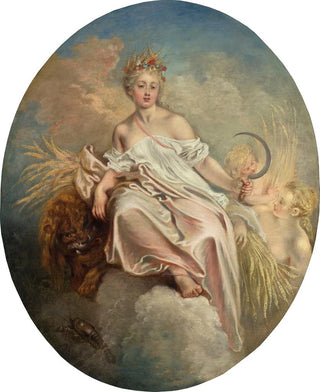Art print | Summer of Ceres - Jean-Antoine Watteau


View from behind

Frame (optional)
Jean-Antoine Watteau’s iconic artwork, *Summer of Ceres*, evokes a delicate and dreamy atmosphere, immersing viewers in an idyllic landscape where nature and mythology intertwine. Created in the early 18th century, this piece is a true homage to the beauty of the seasons and the richness of human emotions. Gazing upon this work invites contemplation and escapism, embodying the unmistakable signature of Rococo art. Through his talent, Watteau captures the very essence of summer—a time of joy and celebration—while subtly revealing a touch of melancholy.
**Style and uniqueness of the work**
The style of *Summer of Ceres* is characterized by a palette of warm, luminous colors, where golden and pastel tones blend harmoniously. The figures, dressed in refined costumes, appear to move within a world that is both real and fantastical. Watteau employs a dynamic composition, with flowing lines and graceful poses that create a subtle sense of movement. This painting is imbued with an airy lightness, typical of Rococo aesthetics, emphasizing elegance and sensuality. The meticulous details of the drapery and facial expressions showcase the artist’s exceptional craftsmanship. Ceres, goddess of agriculture, is depicted surrounded by her attributes, symbolizing fertility and abundance. This work transcends a simple mythological representation, becoming a true reflection of the aspirations and desires of the era.
**The artist and his influence**
Jean-Antoine Watteau is a central figure in French art history, renowned for pioneering the genre of fête galante, which depicts the pleasures of aristocratic life. His innovative approach combines genre painting with mythological elements, creating a unique visual language. Watteau masterfully captures the delicacy of human interactions, blending intimacy with elegance. His influence extends far beyond his time, inspiring many artists such as François Boucher and Jean-Baptiste-Siméon Chardin, who

Matte finish

View from behind

Frame (optional)
Jean-Antoine Watteau’s iconic artwork, *Summer of Ceres*, evokes a delicate and dreamy atmosphere, immersing viewers in an idyllic landscape where nature and mythology intertwine. Created in the early 18th century, this piece is a true homage to the beauty of the seasons and the richness of human emotions. Gazing upon this work invites contemplation and escapism, embodying the unmistakable signature of Rococo art. Through his talent, Watteau captures the very essence of summer—a time of joy and celebration—while subtly revealing a touch of melancholy.
**Style and uniqueness of the work**
The style of *Summer of Ceres* is characterized by a palette of warm, luminous colors, where golden and pastel tones blend harmoniously. The figures, dressed in refined costumes, appear to move within a world that is both real and fantastical. Watteau employs a dynamic composition, with flowing lines and graceful poses that create a subtle sense of movement. This painting is imbued with an airy lightness, typical of Rococo aesthetics, emphasizing elegance and sensuality. The meticulous details of the drapery and facial expressions showcase the artist’s exceptional craftsmanship. Ceres, goddess of agriculture, is depicted surrounded by her attributes, symbolizing fertility and abundance. This work transcends a simple mythological representation, becoming a true reflection of the aspirations and desires of the era.
**The artist and his influence**
Jean-Antoine Watteau is a central figure in French art history, renowned for pioneering the genre of fête galante, which depicts the pleasures of aristocratic life. His innovative approach combines genre painting with mythological elements, creating a unique visual language. Watteau masterfully captures the delicacy of human interactions, blending intimacy with elegance. His influence extends far beyond his time, inspiring many artists such as François Boucher and Jean-Baptiste-Siméon Chardin, who






